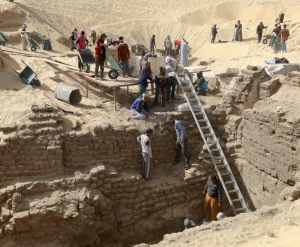The discovery of the tomb of an ancient pharaoh -- the second report in as many months -- leads a recent spate of archaeological finds from Egypt and casts new light on a formative period of the civilization along the Nile.
古埃及法老陵墓的發現--這是短短數月內的第二份相關報告--引領了埃及近期一系列考古發現的熱潮,并為尼羅河流域文明形成時期帶來了新的認識。
In December and January, a team of American and Egyptian archaeologists excavated the roughly 3,600-year-old tomb near the Abydos archaeological site, on the edge of the desert west of the Nile and about 20 miles northwest of the modern city of Luxor in southern Egypt.
去年12月和今月,一支由美國和埃及考古學家組成的團隊在阿拜多斯考古遺址附近發掘了一座約有3600年歷史的陵墓,該遺址位于尼羅河西岸的沙漠邊緣,埃及南部城市盧克索西北約20英里處。
Egypt's antiquities ministry announced the find in a Facebook post last month.
埃及文物部上個月在Facebook上宣布了這一發現。
But the name of the pharaoh who was once entombed there is unknown, as are many of the details about the dynasty of kings he belonged to.
但曾經安葬在這座陵墓中的法老的名字無人知曉,關于他所屬王朝的許多細節也不得而知。
"Egypt was broken apart into multiple rival kingdoms when these kings were ruling," says Joe Wegner, an Egyptologist at University of Pennsylvania who led the excavation. "There was a lot of conflict and turmoil."
“在這些國王統治時期,埃及分裂成了多個相互敵對的王國,”領導此次發掘工作的賓夕法尼亞大學埃及古物學家喬·韋格納說,“當時存在著大量的沖突和動蕩。”

One of Egypt's oldest cities, Abydos was a center for the cult of the god Osiris, a synthesis of different Egyptian beliefs about death, resurrection and kingship.
阿拜多斯是埃及最古老的城市之一,曾是崇拜奧西里斯神的中心,奧西里斯神融合了古埃及人關于死亡、復活和王權的不同信仰。
The modern name comes from a Greek version of the ancient Egyptian name Abedju.
其現代名稱源自古埃及名稱“Abedju”的希臘語版本。
A royal necropolis -- from the Greek words for "city of the dead" -- was established near Abydos in about 1839 B.C. with the burial there of the powerful 12th dynasty pharaoh Senusret III. But Egypt soon fell prey to factional rulers.
大約在公元前1839年,一個皇家墓地--意為 “死者之城”--在阿拜多斯附近建立,強大的第十二王朝法老塞努塞爾特三世就安葬于此。但埃及很快就成為了各派統治者爭奪的對象。
Early Egyptologists excavated Senusret's tomb at Abydos in 1901 and 1902, but the site was abandoned to the desert sands a few years later.
早期的埃及古物學家在1901年和1902年對塞努塞爾特在阿拜多斯的陵墓進行了發掘,但幾年后這個遺址就被遺棄在沙漠的沙土之中。
In the mid-1990s, however, Wegner's team started a new phase of excavations at Abydos; as well as making new investigations of Senusret's tomb, they've discovered the tombs of several "lost" kings, including the tomb of the pharaoh Senebkay in 2014.
然而,在20世紀90年代中期,韋格納的團隊在阿拜多斯開啟了新一輪的發掘工作;他們不僅對塞努塞爾特的陵墓進行了新的調查,還發現了幾位 “失落” 國王的陵墓,包括2014年發現的法老塞內布凱的陵墓。
All belonged to the same dynasty that ruled at Abydos, and their tombs date from the final phases of the royal necropolis there, roughly between 1650 B.C. and 1550 B.C., Wegner says.
韋格納說,這些國王都屬于在阿拜多斯統治的同一個王朝,他們的陵墓可以追溯到該皇家墓地的最后階段,大約在公元前1650年至公元前1550年之間。












